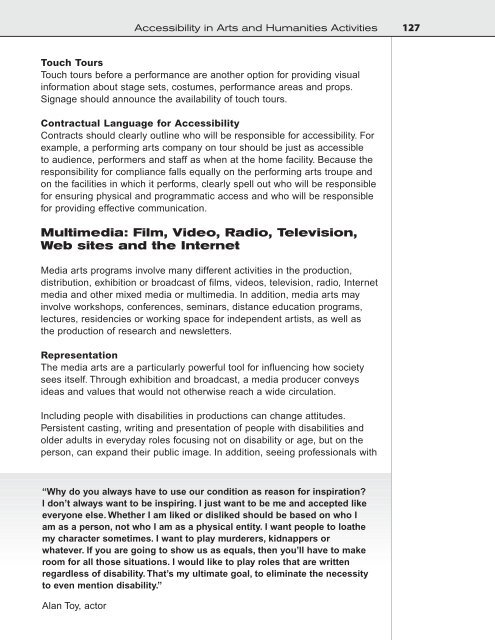Design for Accessibility: A Cultural Administrator's Handbook
Design for Accessibility: A Cultural Administrator's Handbook
Design for Accessibility: A Cultural Administrator's Handbook
You also want an ePaper? Increase the reach of your titles
YUMPU automatically turns print PDFs into web optimized ePapers that Google loves.
<strong>Accessibility</strong> in Arts and Humanities Activities 127<br />
Touch Tours<br />
Touch tours be<strong>for</strong>e a per<strong>for</strong>mance are another option <strong>for</strong> providing visual<br />
in<strong>for</strong>mation about stage sets, costumes, per<strong>for</strong>mance areas and props.<br />
Signage should announce the availability of touch tours.<br />
Contractual Language <strong>for</strong> <strong>Accessibility</strong><br />
Contracts should clearly outline who will be responsible <strong>for</strong> accessibility. For<br />
example, a per<strong>for</strong>ming arts company on tour should be just as accessible<br />
to audience, per<strong>for</strong>mers and staff as when at the home facility. Because the<br />
responsibility <strong>for</strong> compliance falls equally on the per<strong>for</strong>ming arts troupe and<br />
on the facilities in which it per<strong>for</strong>ms, clearly spell out who will be responsible<br />
<strong>for</strong> ensuring physical and programmatic access and who will be responsible<br />
<strong>for</strong> providing effective communication.<br />
Multimedia: Film, Video, Radio, Television,<br />
Web sites and the Internet<br />
Media arts programs involve many different activities in the production,<br />
distribution, exhibition or broadcast of films, videos, television, radio, Internet<br />
media and other mixed media or multimedia. In addition, media arts may<br />
involve workshops, conferences, seminars, distance education programs,<br />
lectures, residencies or working space <strong>for</strong> independent artists, as well as<br />
the production of research and newsletters.<br />
Representation<br />
The media arts are a particularly powerful tool <strong>for</strong> influencing how society<br />
sees itself. Through exhibition and broadcast, a media producer conveys<br />
ideas and values that would not otherwise reach a wide circulation.<br />
Including people with disabilities in productions can change attitudes.<br />
Persistent casting, writing and presentation of people with disabilities and<br />
older adults in everyday roles focusing not on disability or age, but on the<br />
person, can expand their public image. In addition, seeing professionals with<br />
“Why do you always have to use our condition as reason <strong>for</strong> inspiration?<br />
I don’t always want to be inspiring. I just want to be me and accepted like<br />
everyone else. Whether I am liked or disliked should be based on who I<br />
am as a person, not who I am as a physical entity. I want people to loathe<br />
my character sometimes. I want to play murderers, kidnappers or<br />
whatever. If you are going to show us as equals, then you’ll have to make<br />
room <strong>for</strong> all those situations. I would like to play roles that are written<br />
regardless of disability. That’s my ultimate goal, to eliminate the necessity<br />
to even mention disability.”<br />
Alan Toy, actor


